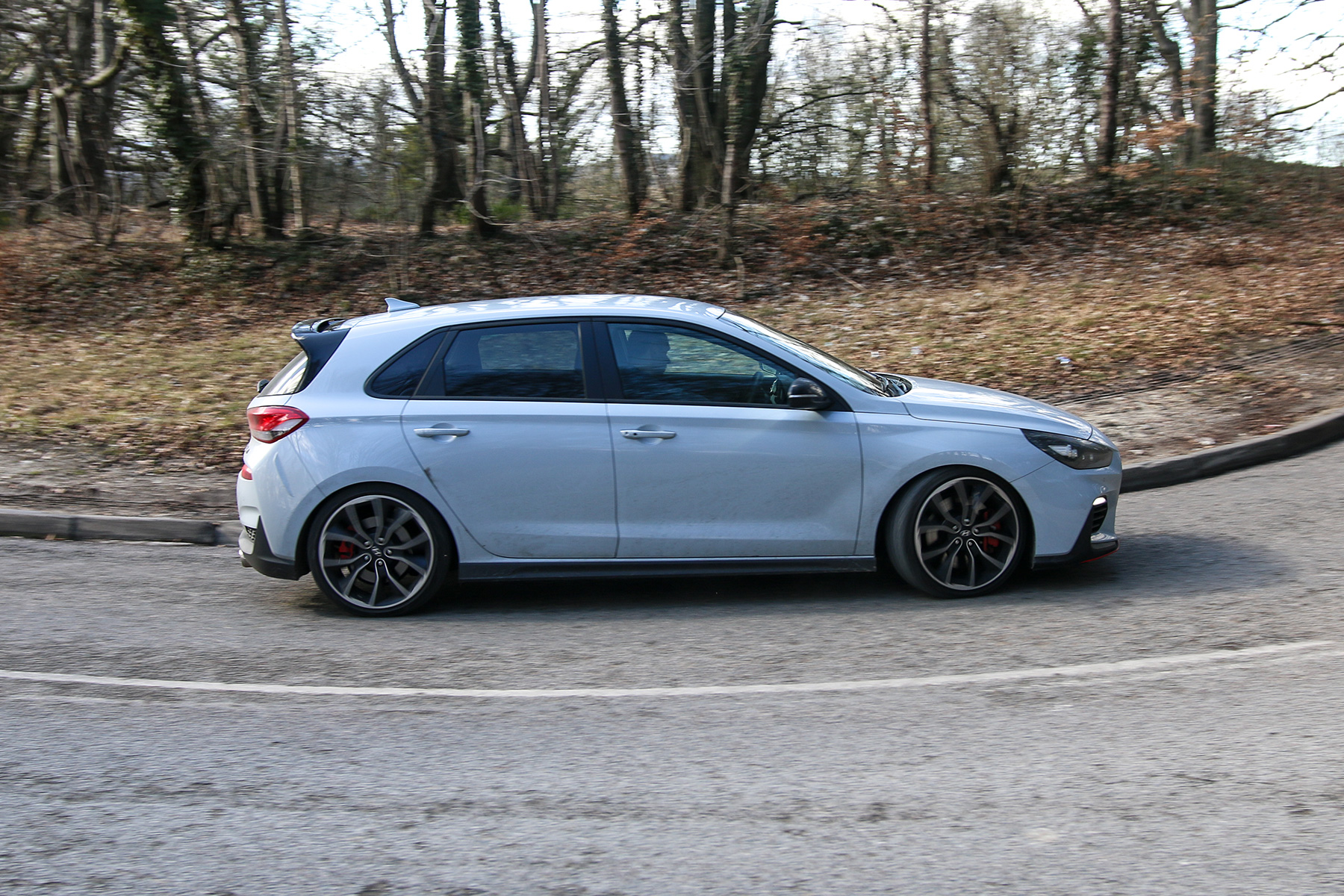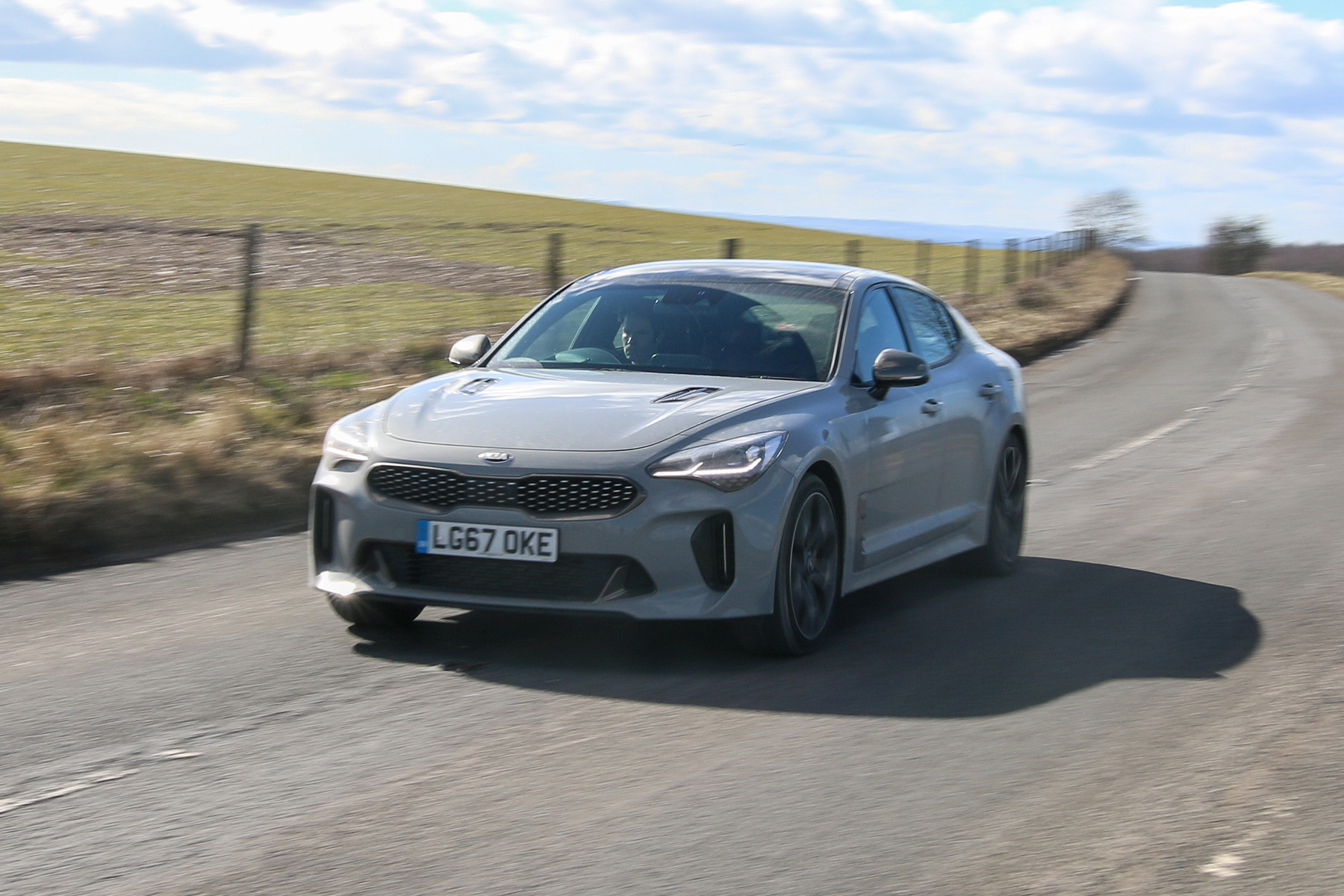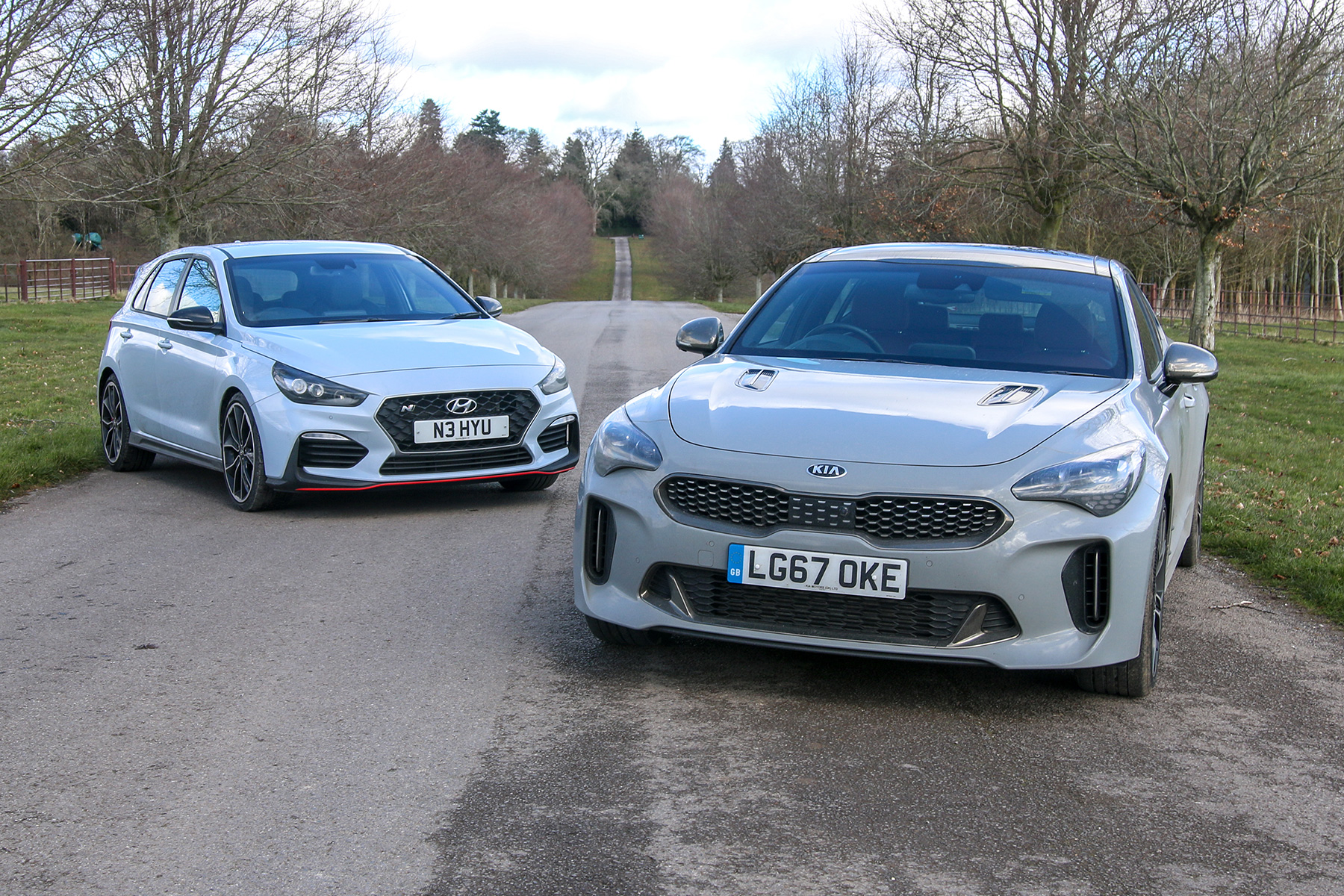
Tim didn’t have the face of a man who had enjoyed his drive. We’d arranged to meet at the site of a former Little Chef on the A303; I’d driven up from Devon in a Kia Stinger GT-S, Tim arrived from Croydon in a Hyundai i30 N.
He was late. “Rubberneckers were gawping at a crash on the other side of the road,” he complained, before muttering something about the artificial pop-pops from the i30 N’s exhaust. It’s fair to say that Tim wasn’t in the best of spirits.
I’d experienced no such problems. Leaving a cold and frosty Dartmoor, roads still lined by piles of drifting snow, I had settled into the sumptuous Nappa leather upholstery of Kia’s performance flagship, climate control set to just-so, steering wheel and seats warming my extremities.
This wasn’t a morning to engage Sport+ mode, which disengages the traction control. But for weaving in and out of the slow-moving traffic on the A30 and A303, the Stinger was proving itself to be an impressive GT car.
No objections to a rowdy exhaust, but the i30N makes EXACTLY THE SAME three pops every time you downshift. It’s all a bit artificial. pic.twitter.com/wCgIHwwaBo
— Tim Pitt (@timpitt100) March 8, 2018
I arrived with time to spare, able to enjoy a large Americano before Tim and Bradley, our videographer for the day, loomed into view over the Wiltshire horizon. Bradley had dispatched with the i30 N many miles previously, providing further evidence that Tim wasn’t warming to the Hyundai.
If a hot hatch fails to stimulate a response to an upstart in a 1.4-litre Corsa, it’s probably not fit to wear the badge. “Do you want to swap cars?” asked Tim. I declined the invitation. I was having too much fun in the Kia and Tim wasn’t exactly selling the Hyundai very well.
From our rendezvous near West Knoyle, we made our way down the A350 to our base camp for the day: the top of Zig-Zag Hill, on Cranborne Chase. Where better than Britain’s bendiest road to test two of the more welcome ‘beasts from the east’? Drivers can expect to experience the same gravitational forces as on a rollercoaster: maybe this would be enough to lift Tim’s gloom.
From white goods to white knuckles
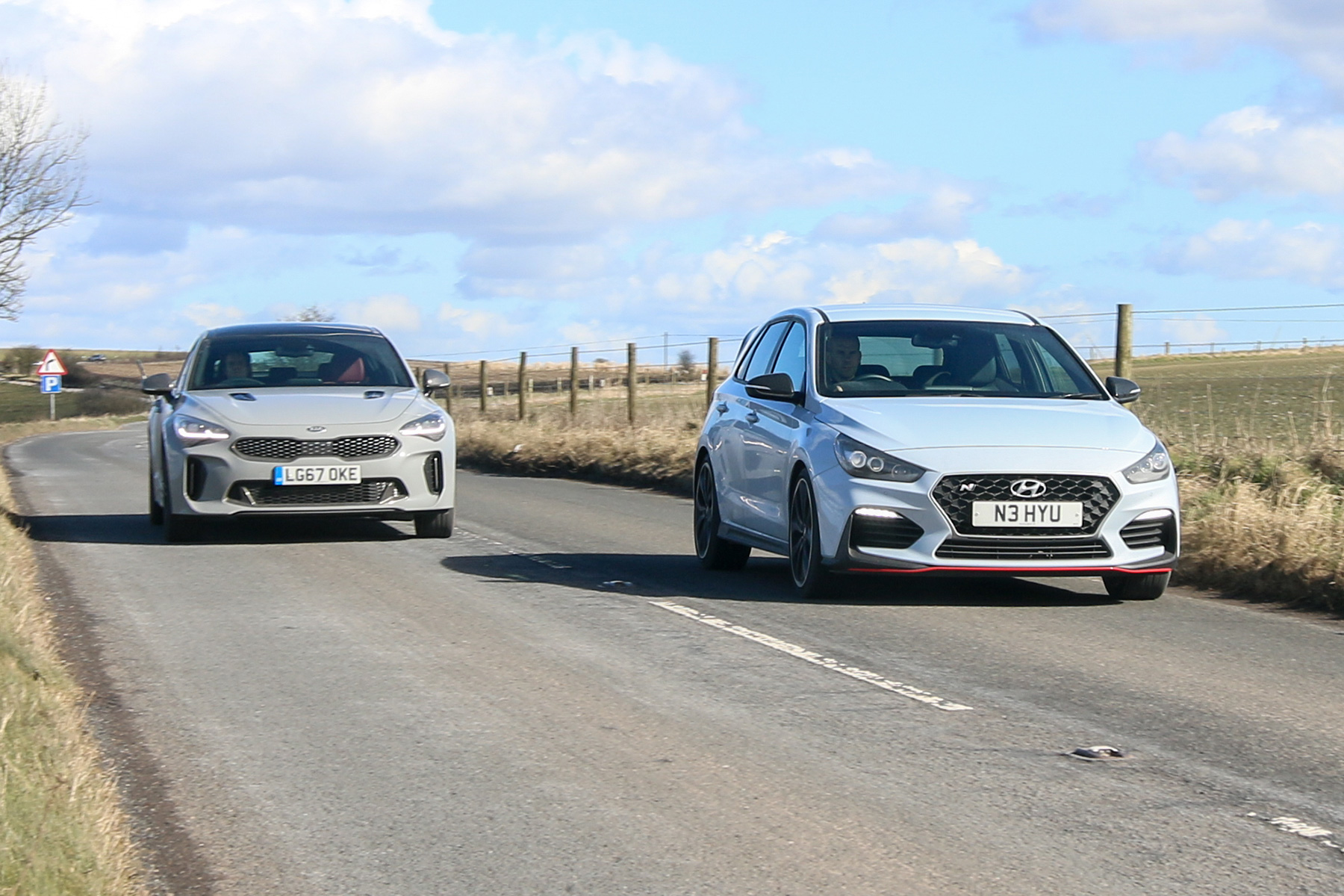
This wasn’t intended to be your stereotypical twin-test. The cars are at opposite ends of the performance car spectrum, appealing to very different demographics. Brogues and Converse, tweed and Superdry, etc.
No, the point of gathering these two Korean missiles atop a windswept hill in Wiltshire was to mark a changing of the guard. There’s a sense that these cars represent so much more than two performance weapons: there’s a bigger story to tell here.
The Stinger GT-S and i30 N lay down a line of tyre rubber on the road: these brands are shifting from an image of warranties and white goods to wantonness and white knuckles. All of a sudden, where once upon a time people would describe Korean cars in the context of boot size, fuel economy and length of warranty, we’re discussing 0-62mph times, launch control and G-forces.
Video: Kia Stinger GT-S and Hyundai i30 N
Specifications
Of the two, the Kia Stinger enjoyed the most exposure. An appearance on The Grand Tour, numerous front-page features and favourable comparisons with German rivals gave the Stinger – in particular the GT-S – more column inches and screen time than any previous Kia model. This all feels a long way from a rebadged Mazda 121 sat on whitewall tyres.
The specs are compelling: 370hp from a 3.3-litre twin-turbocharged V6 engine, enabling the rear-wheel-drive GT-S to hit 62mph from rest in just 4.9 seconds, before maxing out at an Audi-baiting top speed of 168mph. It’s the most exciting South Korean to land in the UK since Song Heung-min arrived at White Hart Lane.
Or is it? The Hyundai i30 N’s figures are no less compelling. In Performance guise, as tested here, the hot Hyundai develops 275hp from its 2.0-litre turbocharged engine, sprinting to 62mph in 6.1 seconds and going on to reach a top speed limited to 155mph.
In a drag race, the Stinger would leave the i30 trailing in its wake. But outright speed is only half the story. By Kia’s own admission, the Stinger is not a ‘hard-edged sports car created to be brutally fast at the expense of comfort’, and it’s worth pointing out that the i30 N was developed by none other than Albert Biermann of BMW M car fame.
For its first high-performance car, Hyundai could have taken the easy route: increase the power, stiffen the suspension, add some larger wheels and cosmetic upgrades and, hey presto, a hot hatch is born. Only Hyundai didn’t take the easy route: there would have been little point hiring Mr M to create the first N-car, only to leave a few stones unturned.
To this end, the i30 N Performance features an electronic limited-slip differential, Pirelli P Zero tyres, an active variable exhaust system, reinforced brakes, multiple adjustments for the driver’s seat, 19-inch alloy wheels, an additional 25hp over the standard N, plus the same 260lb ft of torque, albeit spread over a wider rev range.
But both N cars get five different driving modes – Eco, Normal, Sport, N and N Custom – activated via two blue buttons on the steering wheel. Much has been made about the 1,944 different settings, but in reality, once you’ve found the optimum set-up, you’ll rarely feel the need to change it. But more on the i30 N later.
GT car: Kia Stinger GT-S
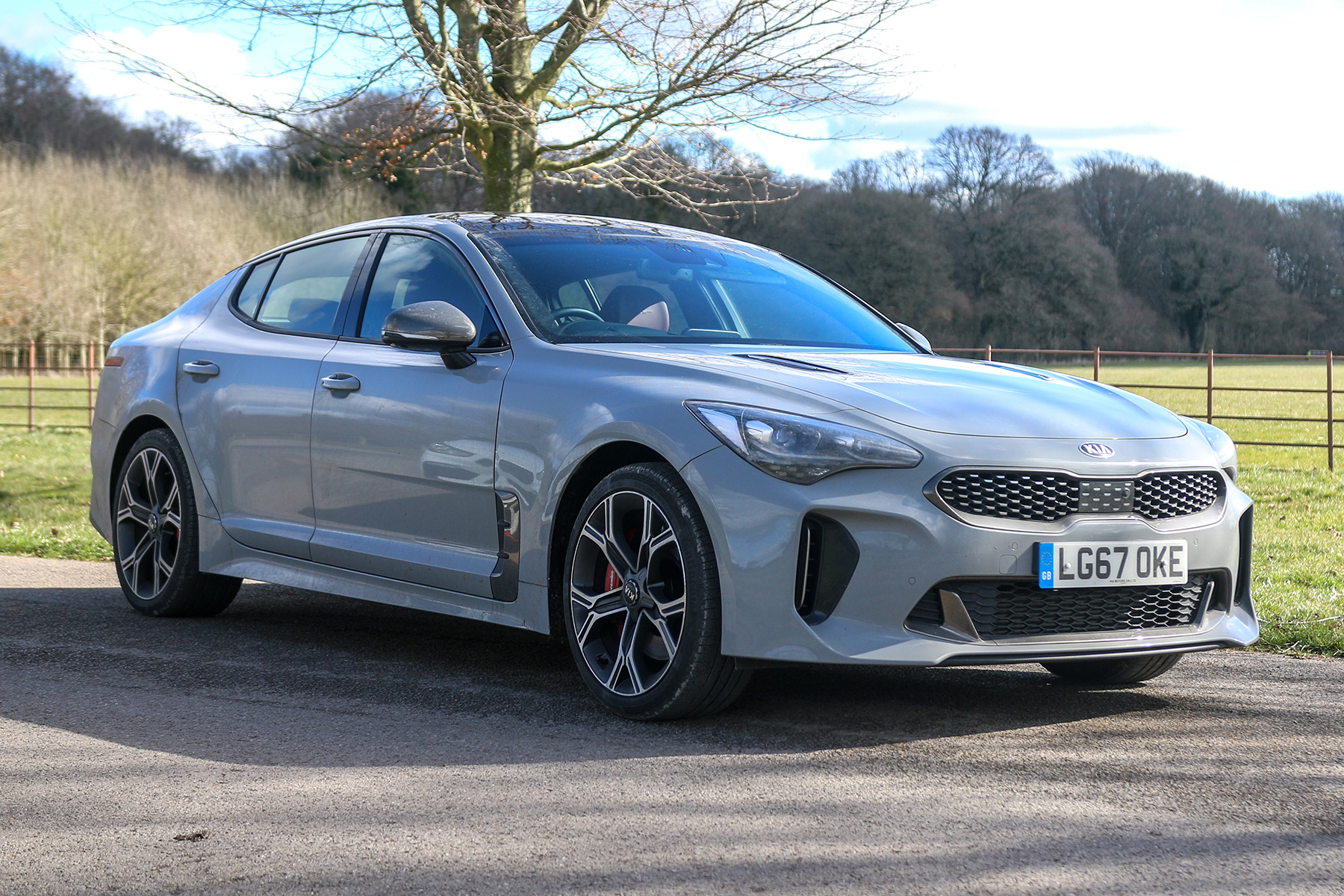
For now, I’m at the wheel of the Kia Stinger GT-S, covering ground on the gloriously open, if a little pockmarked, B3081 across Cranborne Chase. There’s no getting away from the sense that the GT-S would feel more at home on a long distance dash to the south of France or the Swiss Alps, but the Kia’s ability to cover ground quickly and gracefully is nothing short of extraordinary.
It’s that man Albert Biermann again, who took charge of the Stinger’s 10,000km testing regime at the Nürburgring Nordschleife. Let’s hope the German negotiated a decent package when he arrived at the Hyundai-Kia R&D centre. On the basis of what he has achieved so far, Biermann ought to be in line for a hefty bonus.
You sit low, hemmed in by a supremely comfortable heated and ventilated driver’s seat, with four-way lumbar support and two-way side bolster support. The D-shaped heated steering wheel is electronically adjustable, enabling you to find the perfect driving position. First impressions are great.
Things take a turn for the worse when you press the start button, as the V6 engine roars into life with all the sonorous pleasure of an electric toothbrush. There’s a slight improvement when you switch to Sport mode, which relays the engine note through the audio system, but the soundtrack is not a Stinger strong point. A deliberate ploy by the engineers: less shouty and more subtle than the German rivals? Who knows.
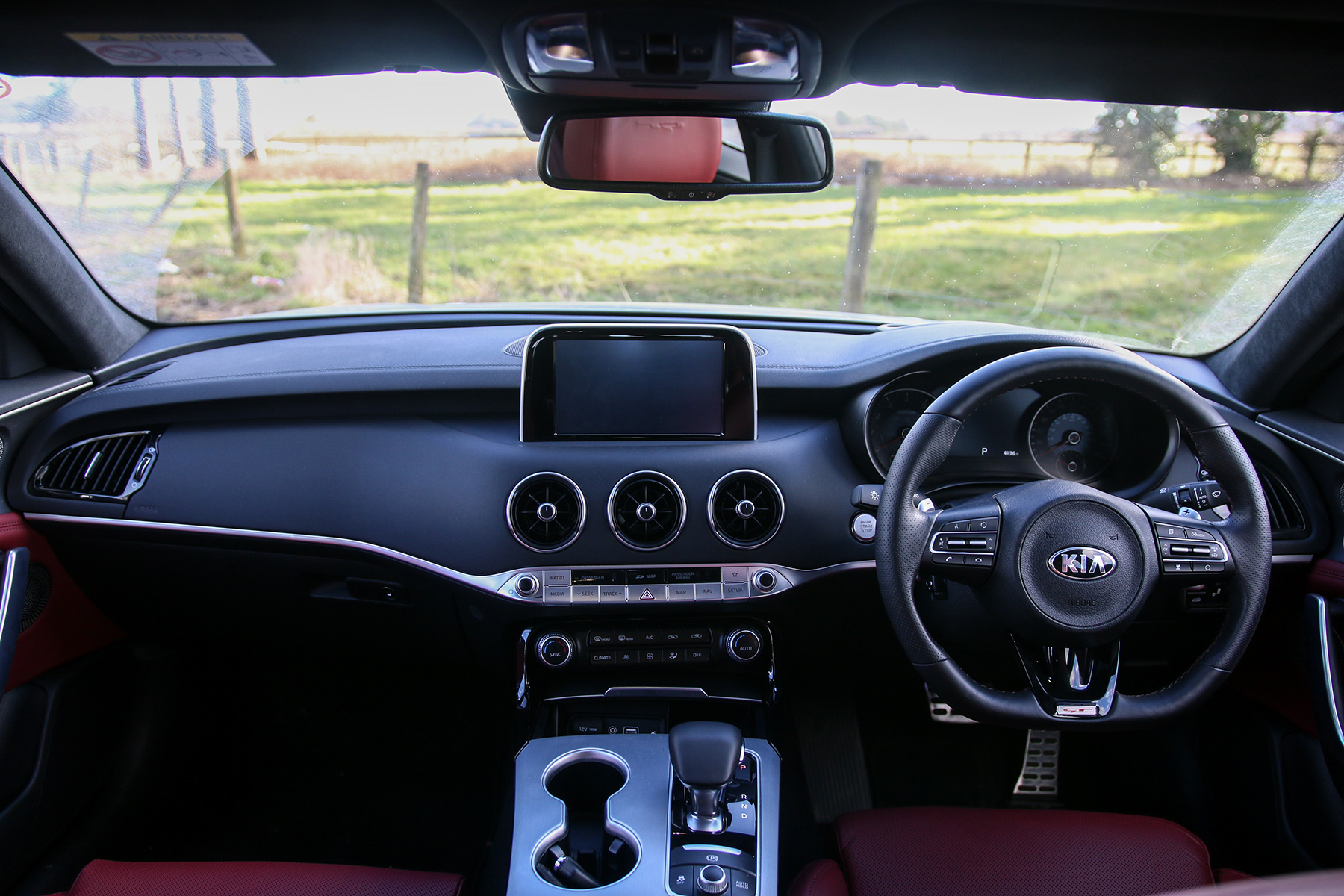
But you’re unlikely to be underwhelmed by the cabin. From the microsuede covering the A-pillars and roof lining to the brushed metal on the centre console, the quality of the fit and finish, while not quite up to German standards, is impressive. There’s a bit of unwanted movement from the controls and switches, but I’d defy anyone who is left feeling shortchanged by the interior.
On the move, the first thing that strikes you about the Stinger GT-S is the explosive performance. Power peaks at 6,000rpm, but 376lb ft of torque is available from 1,300pm to 4,500rpm. At 1,907kg, it’s not a lightweight car, but the torque enables you to attack the road with real venom.
It defaults to Comfort mode, but switching to Sport adds weight to the steering, stiffens the suspension and makes the soundtrack slightly less disappointing. The Eco mode is all but redundant in a car like this and gives the Stinger a severe case of lethargy. Like clunk-clicking your seatbelt, most GT-S owners will engage Sport mode as part of their pre-launch ritual.
It’s the low to mid-range punch that is most impressive, making the sprint between corners surprisingly enjoyable for a car of this size and weight. The eight-speed automatic transmission is, for the most part, able to keep up with the ferocious pace, only occasionally selecting the wrong gear when attempting a fast exit from a bend. The paddle-shifters feel suitably weighty, but annoyingly, the system defaults to auto mode after 10 seconds. On a B-road blast, this could become a major annoyance.
The steering is well-weighted if a little lacking in outright feel, but the Stinger is more agile than you’d expect. Sport mode even grants you a dollop of oversteer to give the Kia a more playful edge. Those with more talent and courage would engage Sport+ to release the shackles, but on these roads and at temperatures barely above freezing, I wasn’t going to be that guy.
Besides, you get the sense that the Stinger is more at home fulfilling GT duties than it is mixing it with GTIs. The ride quality is supple, even in Sport mode, while only a tiny amount of wind noise from the door mirrors blots an otherwise near-faultless NVH report. The levels of refinement reach far beyond the £42,595 price tag. And, yes, it’s definitely worth the money.
Fish finger sandwiches and John Peel
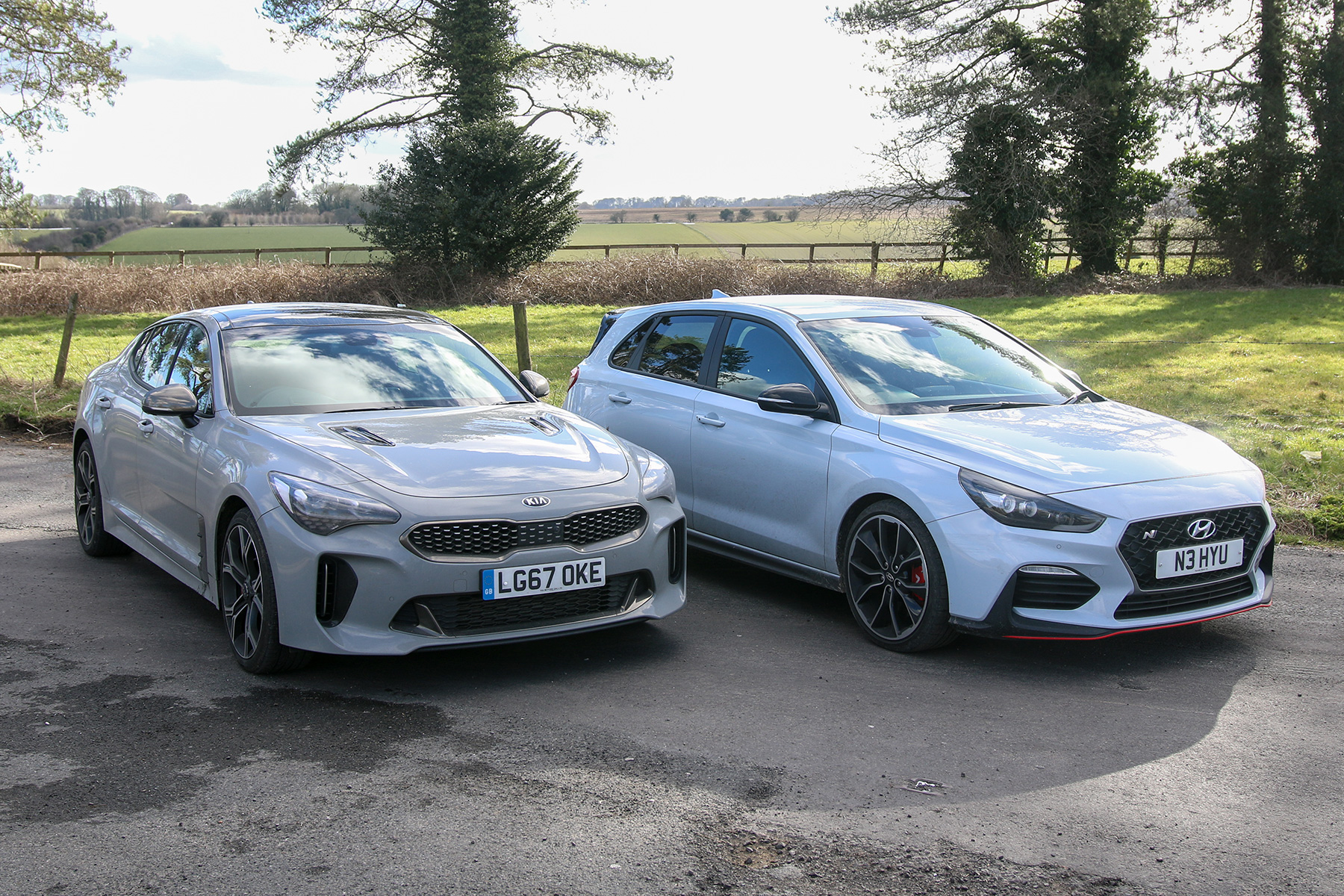
By now, Bradley was itching to take some photos, which gave us the opportunity to reflect on the styling of these two jewels in the South Korean car industry crown. You wouldn’t call either of them beautiful, but the Kia is the more attractive of the two.
And so it should be. The i30 N only needs to look good at night, under the orange lights of a retail centre car park or within sight of the McDonald’s drive-thru. It falls somewhere between the sombre-suited Peugeot 308 GTI and the OK-if-you’re-an-eight-year-old Honda Civic Type R. Fine from certain angles, but that rear end is, quite frankly, a bit of a mess.
Yeah, so our South Korean feature wasn’t so original, but at least we got to enjoy a fish finger sandwich at the brilliantly retro John Peel cafe in Shaftesbury. pic.twitter.com/5Ca3N91L82
— Gavin Big-Surname (@MajorGav) March 18, 2018
Meanwhile, the Stinger must compete in a sector where image is everything, and is suitably dripping in presence. Sure, it wears the Kia corporate grille, but it looks quite unlike anything else in the range. There’s a lot for the eyes to take in, and on more than one occasion we found ourselves just stood there, staring at the car. It has that effect on people: folk want to know more about it and what it can do. As a statement, the Kia Stinger GT-S probably says more positive things about you than any of its German rivals.
With Bradley happy with his shots, Tim was craving his turn behind the wheel. We retired to the brilliantly retro John Peel cafe in Shaftesbury for fish finger sandwiches and a debrief, before switching cars for the afternoon session.
Hot hatch: Hyundai i30 N
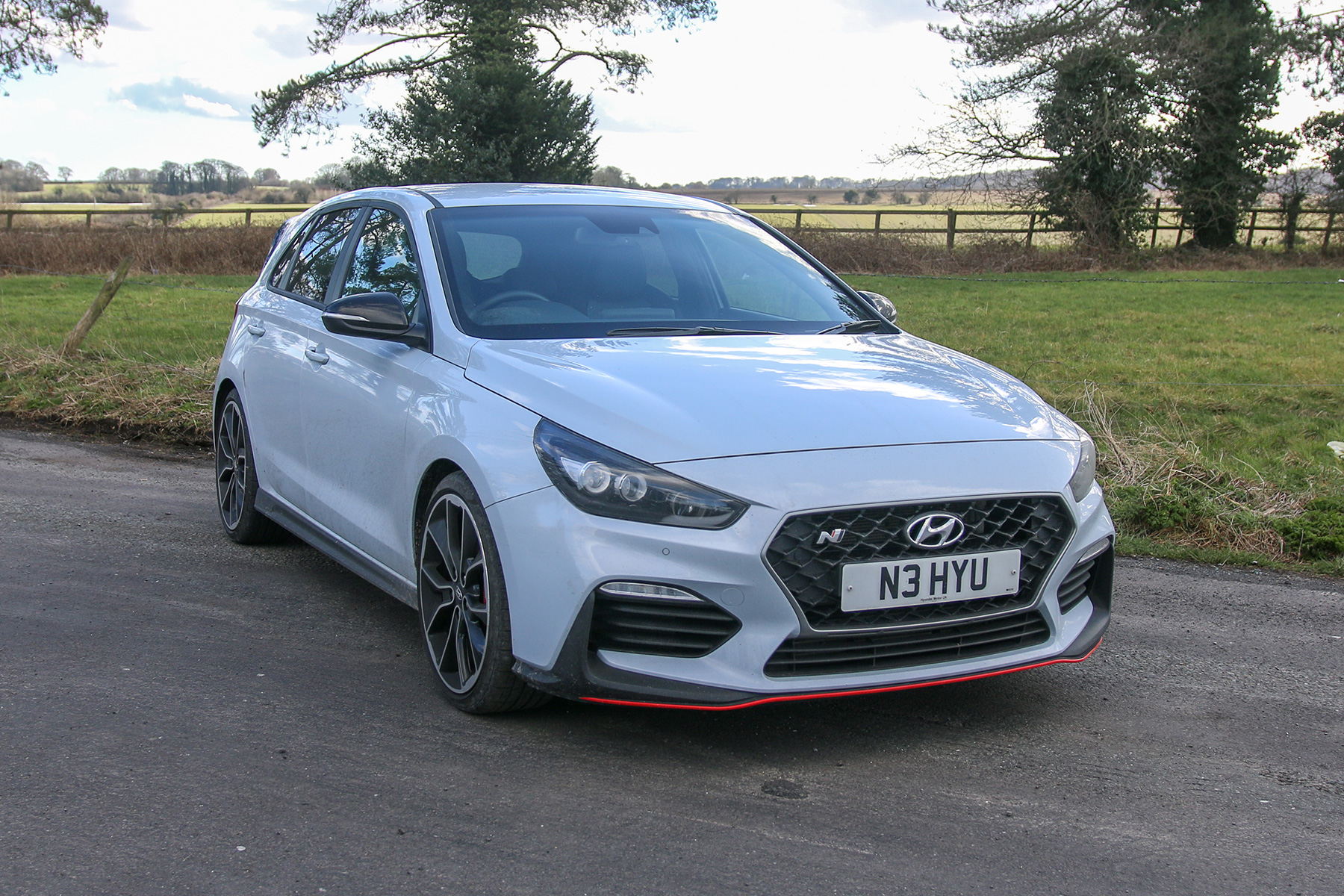
There’s a short drive from the town centre to the bottom of Zig-Zag Hill: just enough time to get used to the switch from GT to hot hatch. First impressions aren’t as favourable: the i30 N’s cabin is bordering on dull, saved only by the sports seats, bespoke gear knob, leather-trimmed steering wheel and N-branded door sill.
But let’s not be too quick to criticise the i30 N. A hot hatch can only work with the tools at its disposal, which is in stark contrast to the Stinger, designed from the ground up to be a lavish GT car. Besides, we’re not here to compare the two cars, and the i30 N Performance is around £12,000 cheaper than its warranty-enriched Korean stablemate.
After the rich and full-bodied Stinger, the i30 N provides more of an espresso-style hit. Unable to resist the temptation to switch to full-on N mode, the i30 reached the foot of Zig-Zag with far more urgency than the Kia. Hardly surprising given that N mode means everything is set at the most intense level.
The exhaust note brings a symphonic soundtrack to the party, creating a sense of theatre that is missing in the Stinger. The burble at idle provides a bucket-load of anticipation, while the ‘after-fire sound’ – or pop-pops, in non-Hyundai speak – is intoxicating and a tiny bit anti-social. If the GT-S could soothe you into middle-aged contentment, the i30 N takes you back a couple of decades. It’s a hooligan, and it’s all the better for it.
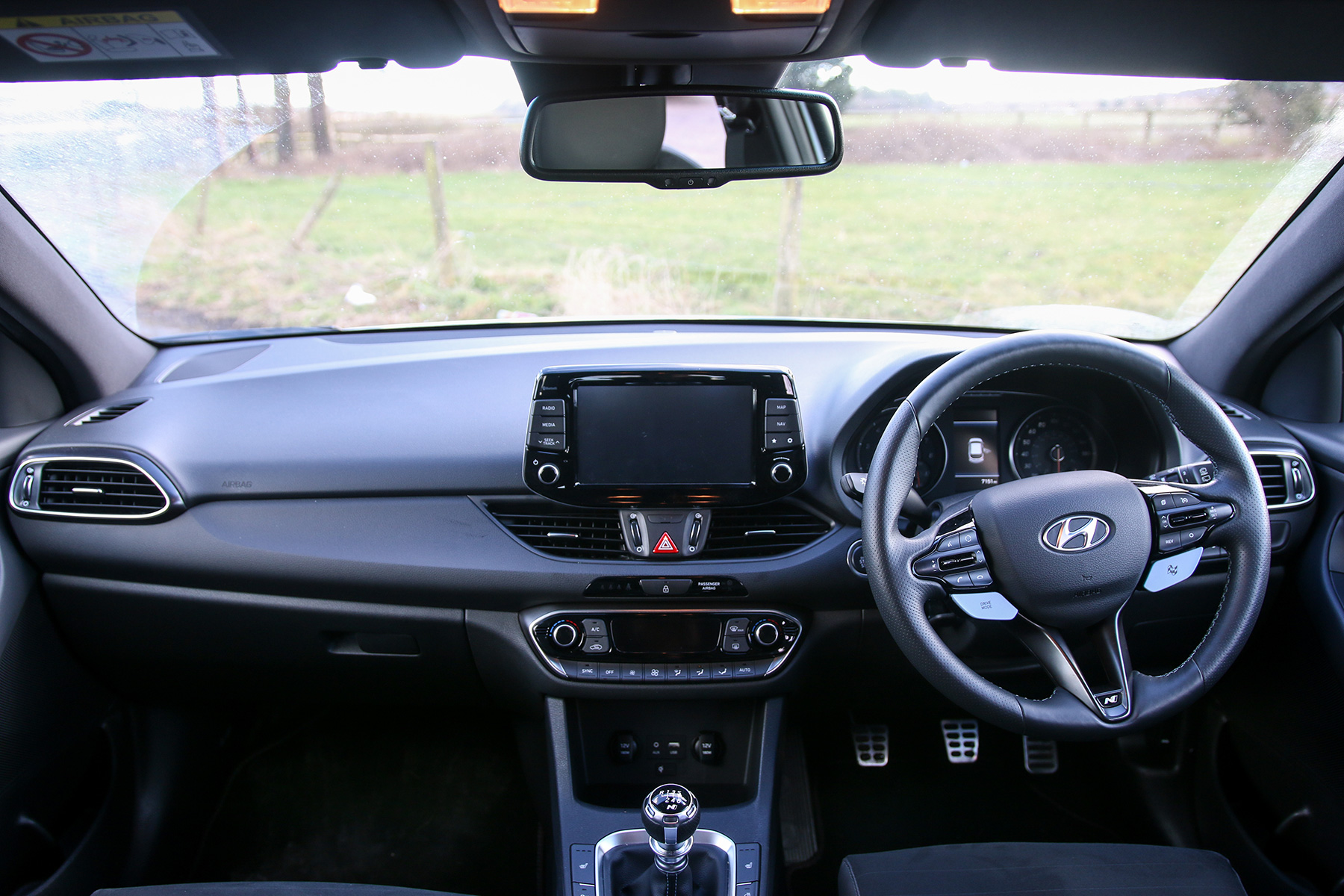
The twists and turns of Zig-Zag Hill must have sounded raucous to anyone within a three-mile radius of the i30 N. You’re forced into first gear to make a swift exit from the tightest bends, but the payback is a sound akin to rapid gunfire, as the exhaust emits a multitude of pops on the over-run. The noise reverberates off the trees as the Hyundai makes its way out of the gloom, blinking as it breaks into the sunlight at the top of the hill.
All the while, that E-diff is working its magic, with the limpet-like grip of the i30 N seemingly unfazed by the less than perfect surface of the hill. Switch to Normal mode, and the Hyundai is far less effective, understeering perilously close to the edge of the road if you attempt to exit a bend too quickly.
Yes, the suspension is almost unbearable in its stiffest setting, bouncing the driver up and down like Tigger on acid. However, as I discovered later, you can use Custom to leave everything in the most extreme setting, but soften the suspension to Sport or even Normal mode. On the roads of the west country, the i30 N felt at home as a cream tea – jam first, cream second – and I stand by my point that you only need two modes: Custom and Normal.
Ninety-nine percent of the time you’ll be in Custom mode, revelling in the heroic rev matching and active exhaust, switching to Normal only to pass horse riders, make a quiet exit from a sleepy village, or to relax on a long and tedious schlep up a motorway. Not that you’ll spend too long on boring roads: the i30 N is the kind of car that encourages you to leave a motorway an exit earlier or to take the long way home, again and again.
Korean two-car garage
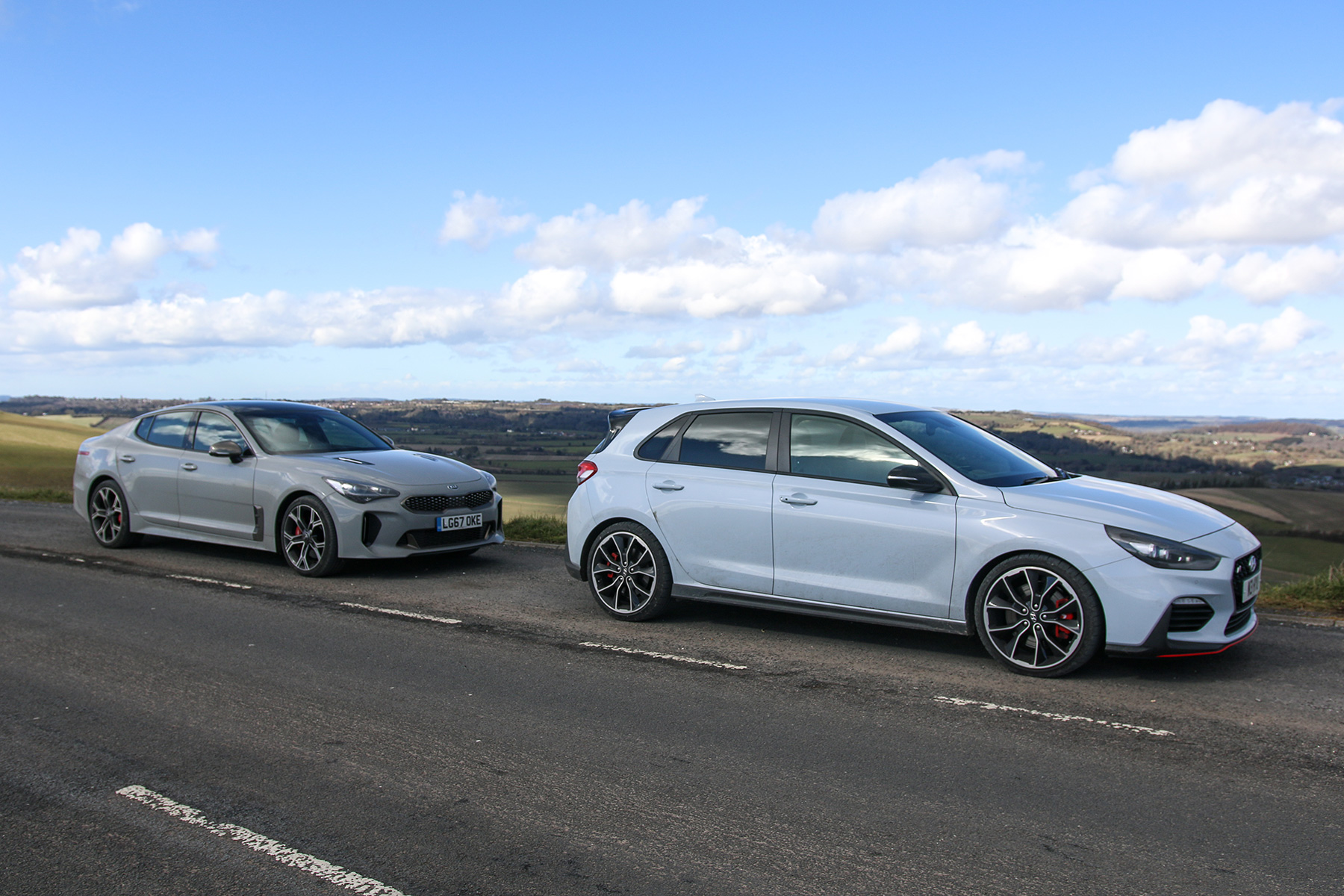
It was becoming increasingly apparent that Tim was finding his groove in the Stinger. As I tucked in behind, hustling Ronin-style through the tight bends, the i30’s unrelenting grip levelling the playing field, I could only watch as the Stinger catapulted away when the road opened up. Occasionally, the rear end would kick out, adding drama to the occasion. Tim spent the afternoon smiling.
From the outside, the Stinger GT-S has a formidable presence, with the quad exhausts acting like a four-barrel signal of intent. In Ceramic Grey (or primer, as some people called it), the GT-S has the look of a prototype vehicle, although opinions are divided on whether or not this is a good thing. Amusingly, the only no-cost option is Ember Orange, which suggests that somebody at Kia has a sense of humour.
I could wax lyrical about these cars forever more and, blissfully free of a word count, I’m dangerously close to doing just that. But, conscious that Tim needs to add his counterpoint, and you’ve got better things to do, I’ll conclude with some passing comments about the two cars.
These aren’t just great performance cars by Korean standards, they’re great, full stop. The Stinger GT-S is arguably the more impressive of the two, and it speaks volumes that, after a week with the car, it looks like excellent value at £42k.
I haven’t driven its key rivals, so I can’t pass comment on its position in the segment, but let me say this…
I’ve just enjoyed one of *the* best drives home. I’m half tempted to carry on to Land’s End.
Buzzin’ pic.twitter.com/fmmgCZLf7r— Gavin Big-Surname (@MajorGav) March 8, 2018
But the i30 N will live long in the memory. Driving back from Zig-Zag Hill, I had one of those drives when the road opens up, the traffic clears, and the planets align. Like the time I drove a Fiesta ST along the entire length of the A470, or a VX220 Turbo on an empty Klausen Pass, or a Racing Puma on the A429 through the Cotswolds – just as the sun was setting. My journey on the A30 in the i30 N gets a chapter in my imaginary book of great drives.
To draw comparisons with other hot hatches would be too miss the point. The i30 N feels like a very special, well-developed and serious performance car. Similar things could be said of the Stinger.
Both deserve to sell in big numbers, but a part of me hopes that they don’t. Many will cling to the tried and tested brands, leaving the enlightened to discover these two heroes. Free-thinkers apply within: extended warranties have never looked more alluring.
Counterpoint: Tim Pitt
Perhaps I expected too much. I’d been looking forward to the i30 N for months, especially after the first slew of five-star reviews. But although it’s a credible contender – and unquestionably the most exciting Hyundai yet – it isn’t the Golf-toppling game-changer some have suggested.
The i30 N is like a Big Mac or Radio 1: fun for short periods but ultimately unsatisfying. My main beef concerns the chassis, which feels slightly leaden in Normal and Sport settings, then responsive but rock-hard in all-guns-blazing N mode. The fast-flowing fluidity of a BMW M140i or Ford Focus RS simply isn’t there.
I’m not sold on the steering either. It’s weighty, but inconsistent – lacking the finely-layered feedback that characterises a great driver’s car. From a standing start, the hot Hyundai is an impressive effort. But I’m sorry Gav, it’s not for me.
The Stinger, on the other hand, feels fit to take on the best in its class. It’s a thoroughly well-sorted sports saloon, with a muscular V6, strong Brembo brakes and playful yet progressive handling. It’s no surprise that Albert Biermann was a key player in the car’s development: remove the badges and you could be driving a BMW.
This isn’t a comparison test, and perhaps the odds are stacked anyway– given that the Kia is over £12,000 more expensive. Still it’s the car that most convincingly takes on the establishment, so the Stinger gets my vote.
Hyundai i30 N Performance
Engine: Four cylinder, 1,998cc, petrol
Drivetrain: Six-speed manual, front-wheel drive
Power: 275hp@6,000rpm
Torque: 260lb ft@1,750rpm
Fuel economy: 39.8mpg
CO2 emissions: 163g/km
Price: £29,810
Kia Stinger GT-S
Engine: Six cylinder, 3,342cc petrol
Drivetrain: Eight-speed semi-auto, rear-wheel drive
Power: 370hp@6,000rpm
Torque: 376lb ft@1,500rpm
Fuel economy: 26.6mpg
CO2 emissions: 225g/km
Price: £42,595
READ MORE:
